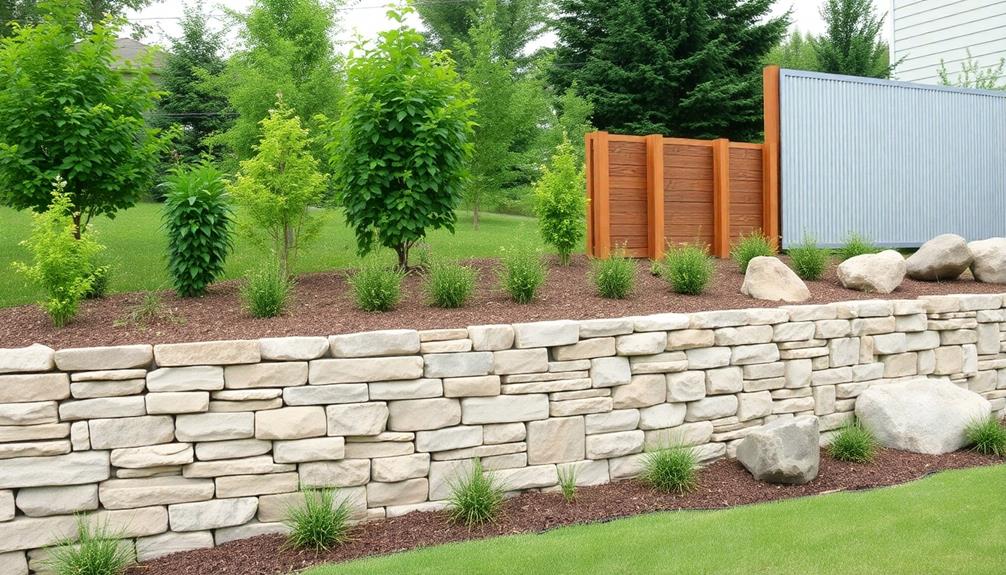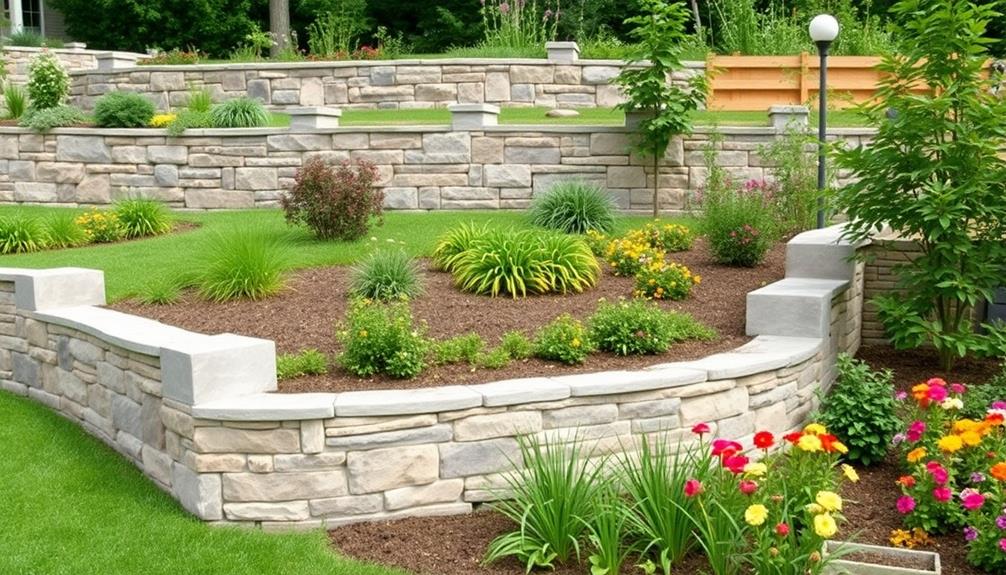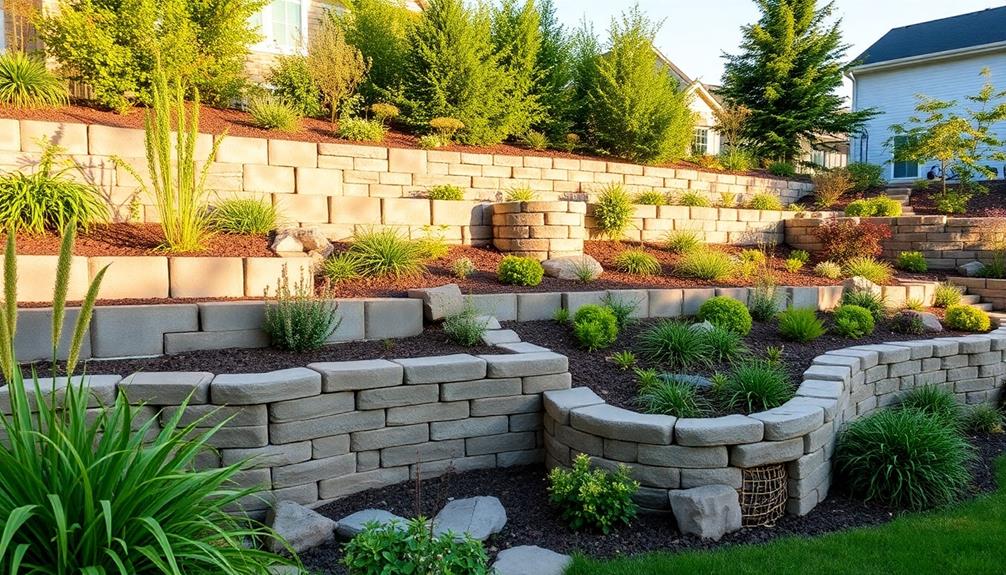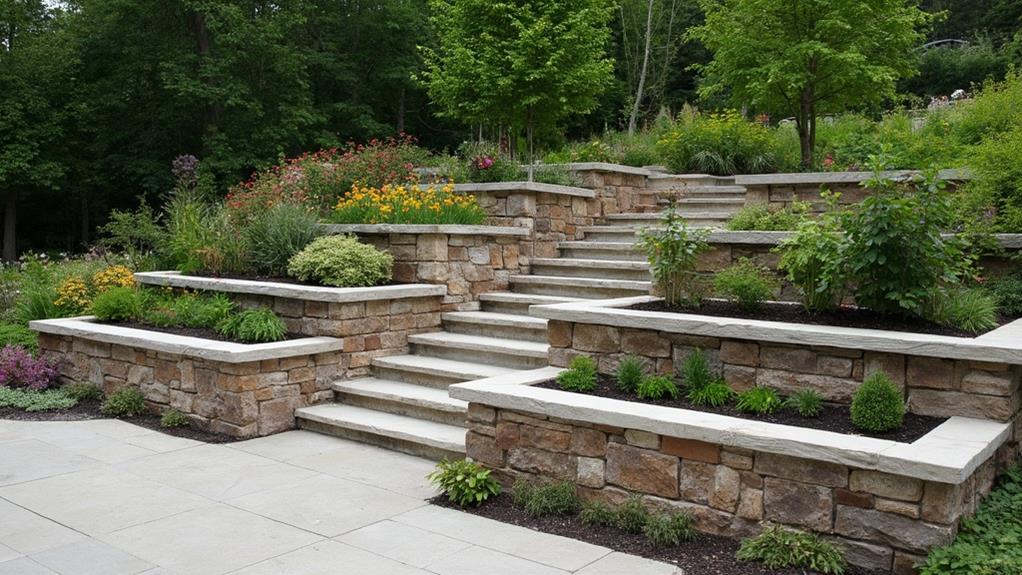When constructing a retaining wall, choice of material is essential to achieve a balance of durability, structural stability, and aesthetics. Concrete blocks are favored for their cost-effectiveness, versatility in design, and enhanced structural integrity due to interlocking features. Natural stones like fieldstone or limestone offer a timeless beauty and robust resilience against environmental pressures, harmonizing well with natural settings. Timber, particularly treated wood, presents a sustainable and customizable option that aids in maintaining environmental consciousness while ensuring resilience against decay and insects. Each material offers unique benefits and considerations that can be explored further for ideal application in retaining wall construction.
Table of Contents
ToggleWalls Contractor Highlights
- Concrete blocks offer interlocking design and durability, making them cost-effective for both residential and commercial retaining walls.
- Natural stone provides aesthetic appeal and environmental harmony, with options like fieldstone, limestone, and sandstone.
- Timber, especially treated wood, ensures durability and ease of installation, with sustainable sourcing enhancing eco-friendly construction.
- Reinforced concrete delivers high compressive strength and adaptability, offering tailored structural support for various engineering designs.
- Material selection is crucial for retaining walls' long-term durability, ensuring structural integrity and community safety.
Types of Retaining Wall Materials

When exploring the diverse materials available for constructing retaining walls, concrete blocks stand out for their versatility and structural integrity, offering a range of design possibilities and ease of installation.
Natural stone choices, such as boulders, make a powerful statement and provide an aesthetic that blends seamlessly with the environment, adding a timeless elegance while ensuring durability and strength. Timber, on the other hand, offers a more rustic appeal and can be employed using various techniques to enhance both the functionality and visual appeal of retaining structures.
Concrete Block Options
Concrete block options are a popular choice for constructing retaining walls due to their durability, versatility, and cost-effectiveness. Engineered to withstand significant lateral earth pressure, these blocks deliver a robust solution for both residential and commercial projects.
Available in a variety of sizes, shapes, and textures, they provide a customizable approach to meet diverse aesthetic and functional needs. Concrete blocks are often interlocking, which simplifies the installation process and enhances structural integrity, making them an efficient choice for DIY enthusiasts and professionals alike.
The versatility of concrete blocks extends to their adaptability in various environments and climates. They resist weathering and erosion, maintaining their structural efficacy over time, which underscores their long-term value. Moreover, the modular nature of concrete blocks allows for flexible design options, accommodating curved or angular wall configurations without compromising stability.
In addition to their structural benefits, concrete blocks are a sustainable option. Many are made from recycled materials, contributing to environmental conservation efforts. This eco-friendly aspect resonates with communities that prioritize sustainability, fostering a sense of belonging among environmentally conscious groups.
Natural Stone Choices
Moving from the engineered precision of concrete blocks, natural stone choices offer a timeless and organic aesthetic for retaining walls, appealing to those who appreciate the inherent beauty of nature. Natural stone provides an enduring charm that harmonizes with its surroundings, making it an ideal choice for creating a sense of unity and belonging within a landscape.
Among the options, fieldstone, limestone, and sandstone stand out, each bringing distinct characteristics that cater to various stylistic and functional needs.
Fieldstone, with its irregular shapes and diverse colors, offers a rustic appeal that enhances the natural environment's existing textures. Limestone, known for its uniformity and light color palette, is prized for its durability and ability to age gracefully, often integrating seamlessly into traditional and modern designs alike. Sandstone, with its warm hues and stratified appearance, adds a touch of elegance and sophistication, making it suitable for creating visually striking retaining walls.
The selection of natural stone not only reflects an aesthetic preference but also involves considerations of local availability and environmental impact, aligning with the values of communities that prioritize sustainability and natural integration in construction. Through thoughtful selection, natural stone choices can transform landscapes into cohesive, enduring spaces.
Timber Utilization Techniques
Among the diverse materials available for retaining wall construction, timber offers a versatile and cost-effective solution favored for its natural appeal and ease of installation. This material, renowned for its warm aesthetic, seamlessly integrates with landscape designs, providing both functionality and visual harmony. Timber retaining walls are typically constructed using treated wood, which guarantees durability by resisting decay and insect damage—a vital factor for longevity in outdoor applications.
When employing timber, several techniques enhance its effectiveness in retaining wall construction. One common method involves using vertical posts set into concrete footings, which support horizontal planks or logs. This design not only secures the structure but also allows for straightforward assembly, making it a popular choice for both DIY enthusiasts and professionals. Additionally, the modular nature of timber allows for easy customization, catering to varied landscape contours and aesthetic preferences.
Moreover, timber's lightweight properties facilitate transport and handling, reducing overall labor costs. Its sustainability is another appealing factor, as responsibly sourced wood contributes to environmentally conscious construction practices. By blending practicality with ecological awareness, timber utilization techniques in retaining wall construction serve as a demonstration to innovation, meeting the desires of those who seek both belonging and environmental responsibility.
Benefits

When selecting materials for retaining walls, several benefits arise, including enhanced structural stability and long-term durability assurance, which are critical for ensuring safety and longevity.
For instance, boulder walls provide a natural and rustic aesthetic while also being low-maintenance and eco-friendly. Additionally, the environmental impact of these materials can be minimized through sustainable sourcing and practices, offering an eco-friendly approach to construction.
Cost-effective solutions also play a pivotal role, enabling projects to stay within budget while maintaining quality and performance standards.
Enhanced Structural Stability
The robustness of retaining wall materials plays a fundamental role in enhancing structural stability, ensuring both safety and longevity. Selecting the right material is essential for the wall to withstand various forces, such as soil pressure, water infiltration, and environmental changes. Materials like reinforced concrete, natural stone, and interlocking concrete blocks are renowned for their ability to provide formidable support and resist deformation. Their intrinsic strength and adaptability to different engineering designs make them ideal choices for constructing walls that are both stable and reliable.
Reinforced concrete is particularly favored for its high compressive strength and versatility, allowing it to be molded into various shapes and sizes to meet specific project requirements. Natural stone, on the other hand, offers not only aesthetic appeal but also inherent durability, making it a timeless choice for those seeking both function and beauty. Interlocking concrete blocks provide additional stability through their unique design, which enhances grip and prevents slippage, contributing to the wall's overall robustness.
Long-Term Durability Assurance
While the choice of robust materials substantially enhances structural stability, ensuring long-term durability is equally important for the sustained performance of retaining walls. This aspect of construction not only safeguards the integrity of the infrastructure but also fosters a sense of community trust and security. Materials like reinforced concrete, natural stone, and treated timber have been recognized for their resilience against environmental stressors, such as moisture infiltration and temperature fluctuations, which can otherwise compromise the longevity of retaining walls.
Reinforced concrete, for instance, offers exceptional durability due to its composition, which can resist both tensile and compressive forces, while natural stone provides an enduring aesthetic appeal combined with inherent strength. Treated timber, though traditionally seen as less durable, is now engineered to withstand decay and insect damage, extending its lifespan significantly. Consequently, the integration of geosynthetics with these materials enhances their performance by improving drainage and reducing erosion risks.
Incorporating these materials in retaining wall construction assures community members of a reliable and enduring solution, capable of withstanding the test of time. In this way, long-term durability not only serves as a technical benefit but also as a cornerstone of communal confidence and peace of mind.
Environmental Impact Considerations
As communities increasingly prioritize sustainable development, the selection of environmentally friendly materials for retaining walls offers significant benefits. By choosing materials like recycled concrete, natural stone, or sustainably sourced wood, communities can reduce their ecological footprint and contribute to environmental preservation. These materials not only align with eco-conscious values but also provide a range of tangible advantages that foster a sense of unity and shared responsibility among residents.
Consider the following benefits of selecting environmentally friendly materials for retaining walls:
- Reduced Carbon Emissions: Utilizing recycled or locally sourced materials diminishes the need for intensive manufacturing processes, thereby lowering greenhouse gas emissions.
- Minimized Landfill Waste: Recycled materials help divert waste from landfills, promoting a circular economy and reducing the strain on waste management systems.
- Enhanced Aesthetics: Natural materials blend seamlessly into landscapes, enhancing the visual appeal and creating harmonious environments that residents can take pride in.
- Biodiversity Support: The use of certain natural materials can promote local biodiversity, providing habitats for native species and strengthening ecological networks.
Cost-Effective Solutions
When considering cost-effective solutions for retaining walls, communities can benefit from an array of options that provide both financial savings and structural integrity. One of the primary benefits of exploring these solutions is the potential for reduced construction and maintenance costs, achieved through the selection of materials that offer durability while minimizing expenses. Concrete blocks, for instance, are a popular choice due to their affordability and ease of installation, offering a balance between cost efficiency and long-term performance.
Furthermore, the use of locally sourced materials, such as natural stone or recycled materials, can remarkably lower transportation expenses and support local businesses, fostering a sense of community and sustainability. These materials not only provide a unique aesthetic appeal but also contribute to the environmental goals of reduced carbon footprints.
Additionally, modular wall systems present an innovative approach, offering ease of assembly and flexibility in design. They allow for efficient construction processes, reducing labor costs and project timelines, while still ensuring the structural demands of retaining walls are met. By integrating these cost-effective solutions, communities can successfully achieve their infrastructure goals, creating resilient spaces that reflect both economic prudence and collective identity.
Cost-Effective Material Options

In the domain of retaining wall construction, selecting materials that balance cost with durability is imperative for achieving both budgetary and structural goals. Affordable concrete solutions offer a blend of strength and longevity, while budget-friendly timber choices present an environmentally conscious option that can be aesthetically pleasing. Economical stone alternatives, though often perceived as high-end, can be sourced strategically to provide a natural appearance without excessive expenditure, as illustrated in the table below.
| Material Type | Cost-Effectiveness Feature |
|---|---|
| Concrete | Long-lasting and strong |
| Timber | Eco-friendly and visually appealing |
| Stone | Natural look with strategic sourcing |
| Recycled Materials | Sustainable and budget-friendly |
| Modular Blocks | Easy installation and flexibility |
Affordable Concrete Solutions
Concrete remains a cornerstone in the domain of retaining wall construction, offering both durability and versatility. As a cost-effective material, concrete solutions cater to those seeking affordable yet robust options. These solutions not only promise to withstand the test of time but also adapt to various aesthetic and structural needs, enhancing the sense of community belonging within residential and commercial landscapes.
Concrete's affordability is primarily attributed to the following factors:
- Material Efficiency: Concrete's intrinsic strength allows for thinner walls, reducing the volume of material required while maintaining stability, thus lowering costs.
- Local Availability: As a globally accessible resource, concrete is easily sourced, minimizing transportation costs and promoting sustainable practices by reducing carbon footprints.
- Ease of Installation: Precast concrete blocks or poured concrete walls can be installed with relative simplicity, minimizing labor expenses and construction time.
- Low Maintenance: Concrete structures often require minimal upkeep, reducing long-term costs and contributing to their reputation as an economical choice.
Choosing affordable concrete solutions aligns with the principles of economic prudence, catering to budget-conscious stakeholders without compromising on quality. By opting for concrete, one invests in a material that is not only financially viable but also environmentally considerate, fostering both individual and communal prosperity.
Budget-Friendly Timber Choices
While concrete offers a robust and enduring option for retaining walls, timber presents a compelling alternative for those seeking both affordability and aesthetic appeal. Timber's natural warmth and versatility make it an attractive choice for homeowners and builders who cherish a connection to nature and community. Its inherent flexibility allows for creative designs that seamlessly integrate with diverse landscaping themes, therefore fostering a sense of belonging among spaces and their inhabitants.
Several budget-friendly timber options exist, each with its unique advantages. Pressure-treated pine is a popular choice due to its cost-effectiveness and resistance to decay and insect damage. This treatment process enhances the wood's durability, making it suitable for retaining wall applications where longevity is desired without sacrificing economic efficiency.
Additionally, reclaimed timber offers an eco-friendly alternative that resonates with sustainability-minded individuals, offering both cost savings and an opportunity to reduce environmental impact.
Moreover, cedar, with its natural resistance to moisture and pests, provides an affordable yet slightly more upscale option for those who value resilience and elegance. Choosing timber for retaining walls not only aligns with budgetary constraints but also enriches outdoor spaces with warmth and character, inviting tranquility and a harmonious connection to the environment.
Economical Stone Alternatives
For those seeking durable and visually appealing retaining wall solutions, economical stone alternatives offer a compelling balance between cost and performance. These materials are not only cost-effective but also bring a sense of belonging to spaces that demand both function and aesthetic value. Embracing these alternatives allows for the creation of walls that stand the test of time while maintaining a connection to their natural surroundings.
Among the most popular economical stone alternatives are:
- Concrete Blocks: These are favored for their flexibility in design and ease of installation. Concrete blocks can mimic the appearance of natural stone, offering a sophisticated look at a fraction of the price.
- Recycled Materials: Utilizing recycled concrete and bricks can substantially reduce costs while promoting environmental sustainability. This choice resonates with eco-conscious homeowners and builders.
- Gabion Walls: Comprising wire cages filled with stones or other materials, gabion walls provide a rustic yet modern aesthetic. They are particularly advantageous in regions prone to erosion.
- Manufactured Stone Veneer: This option delivers the look of natural stone without the associated expense, making it ideal for projects where aesthetics are a priority.
Walls Contractor FAQ
How Do I Determine the Right Material for My Specific Landscape Needs?
To specify the ideal material for your landscape, consider factors such as soil type, climate, aesthetic preference, budget, and structural requirements. Consulting with professionals guarantees a choice that aligns with both environmental and community standards.
Are There Eco-Friendly Retaining Wall Material Options Available?
Yes, eco-friendly options exist, including recycled concrete, gabion walls with natural stone, and sustainably sourced timber. These materials not only support environmental goals but also integrate seamlessly into landscapes, fostering a sense of belonging with nature.
What Are the Maintenance Requirements for Different Retaining Wall Materials?
Maintenance requirements for retaining wall materials vary considerably. Concrete walls require sealing and inspection, while timber needs regular treatment against pests and rot. Natural stone demands cleaning to prevent moss growth, ensuring durability and aesthetic appeal for community spaces.
How Do Weather Conditions Affect the Choice of Retaining Wall Materials?
Weather conditions greatly influence the selection of retaining wall materials, as factors like freeze-thaw cycles, precipitation, and temperature fluctuations determine durability. Choosing appropriate materials promotes longevity and fosters a sense of community safety and shared environmental responsibility.
Can Retaining Walls Be Constructed as a DIY Project Using These Materials?
Retaining walls can indeed be constructed as a DIY project, provided the builder possesses adequate skills and knowledge. Utilizing quality materials and adhering to proper guidelines is essential for creating a structurally sound and aesthetically pleasing wall.







